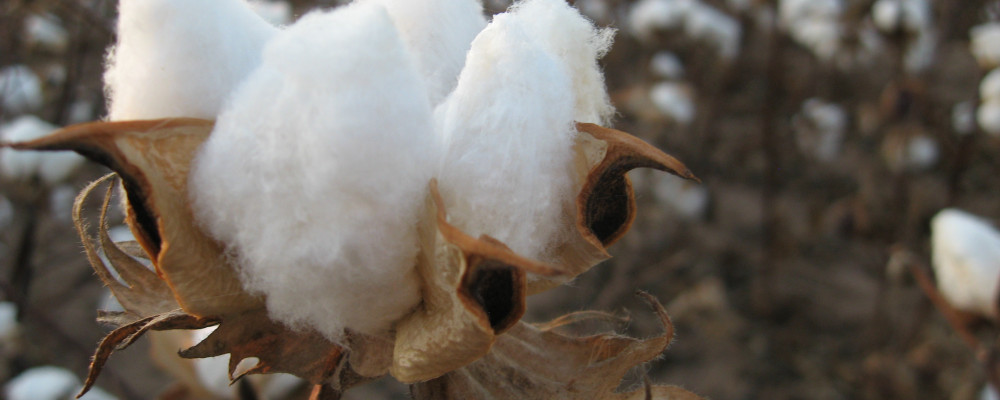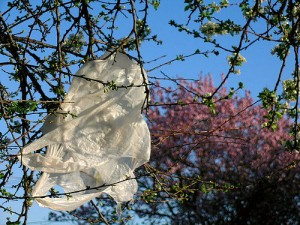
How Is Cotton Biodegradable and Why Is That Good?
Today I want to look at a very widely used term and really get to grips with its meaning: "Biodegradable". How much do you actually know about it? What does it mean? How is it good? How is it bad?!
The problem with being "eco", or anything that's a little niche, is that brands start flinging around terms like biodegradable, recycled, upcycled, green and sustainable, and don't offer any description or explanation as to what they mean. We might begin to just accept these terms, and forget to ask what they're actually talking about. My biggest pet peeve is when brands use the term "Natural" thinking that consumers will just assume it's an ethically produced product - natural what?? Colour, fibre, flavourings, raw material? Being "Natural" doesn't necessarily mean it's good for the planet, or good for you.
What does the term 'biodegradable' even mean? How does it have any relevance to cotton, and why should we be so interested in the first place?

What Is Biodegredation?
Biodegradation is the chemical dissolution (dissolving) of materials by bacteria or other biological means. Once a product has biodegraded, it essentially "disappears". These products can be solids biodegrading into the soil (which we also refer to as compostable), or liquids biodegrading into water.
Nature biodegrades everything it makes back into basic building blocks, so that new living things can be made from the old. Every resource made by nature returns to nature - plants and animals biodegrade, even raw crude oil will degrade when exposed to water, air and the necessary salts.
A leaf is a perfect example of a biodegradable product - it is made in the spring, used by the plant for photosynthesis in the summer, drops to the ground in autumn and assimilated into the soil to nourish the plant for the next season. This process will take about a year.
If a fabric or product is biodegradable, you can determine several things. For a start, it means that the material is made of natural materials, such as wood, cotton, or linen, or artificial materials that are similar enough to plant and animal matter. Biodegradable plastic, for example, will be comprised of a natural ingredient such as cornstarch or vegetable oil. It also means that the material will break down over time, into the chemicals that it was originally composed of. When a manmade compound is formulated in a laboratory, combinations of elements are made that do not exist in nature and there are no corresponding microorganisms to break them down.
Is Compostable The Same As Biodegradable?
Although often interchanged, biodegradable is not the same as compostable. While biodegradable simply means to be consumed by microorganisms and return to the chemicals or "compounds" it was originally composed of, "compostable" specifies that the object be broken down in a compost pile. If a product is compostable, it will biodegrade in the compost heap (a mound of soil).
When Will Something Biodegrade?
For something to be termed biodegradable, it will have specific circumstances where it will start to break down. For example, a piece of paper is not going to biodegrade right in front of you as you are looking at it, but that does not mean that it is not biodegradable. It is not just not in the right setting. Organic material can be degraded aerobically with oxygen, or anaerobically, without oxygen.
Most things that naturally biodegrade will need to be in a warm, light, oxygenated (aerobic) and potentially wet setting. It will also require quite a bit of time. Different materials need different amounts of time to biodegrade. Paper and wood do not take very long, but for materials such as the plastic that carrier bags are made out, scientists have estimated that it takes five hundred years to completely biodegrade.
When Is Biodegrading Bad For The Environment And Wildlife?
1. When The Biodegraded Particles Are Toxic
Is cotton biodegradable? Yes, as a completely natural material grown in fields, cotton is completely biodegradable. This means that cotton has an amazing advantage over many other synthetic materials: We do not have to worry about cotton filling up landfill. As you will know by now, I despise throwing things away - I mend, upcycle, recycle and resurrect everything I can, just to avoid anything heading for landfill. But it's nice to know that cotton and other cellulose fabrics won't be building up in landfill and contributing to methane secretion that cause greenhouse gas buildup.
The downside is when cotton is not grown in an organic way (i.e, it's grown with the use of toxic chemicals) and it biodegrades, when the chemical parts of it are broken down, these nasty chemicals seep back into the ground and harm the surrounding environment. So much damage to land, to other plants, and to other animals that live around the local area are disrupted and destroyed by the release of dangerous toxins from nasty things that are biodegrading – organic cotton does not do that.
Similarly, in his book The Closing Circle, ecologist Barry Commoner gives the example of synthetic detergents. When the benzene unit in synthetic detergents biodegrades in open water, it is converted into phenol (carbolic acid), a substance toxic to fish.

2. When A Product Isn't In the Correct Biodegrading Environment
As I mentioned, the substance has to be in a particular environment to biodegrade - so what happens when it isn't?
Detergents, for example, break down in a natural freshwater “aerobic” (oxygenated) environment, but not in a “anaerobic” environment such as sewage treatment plant digestors, or natural ecosystems such as swamps, flooded soils or surface water sediments.
Many products that are inherently biodegradable in soil, such as foliage, food waste and paper, will not biodegrade when we place them in landfills because the artificial landfill environment lacks the light, water and bacterial activity required for the decay process to begin. The Garbage Project, an anthropological study of our waste conducted by a group at the University of Arizona from 1973 to 2005, unearthed hot dogs, corn cobs and grapes that were twenty-five years old and still recognizable, as well as newspapers dating back to 1952 that were still easily readable. When the conditions needed for biodegradable materials to naturally biodegrade are not provided, major garbage problems are the result.
To be truly biodegradable, a substance or material should break down into carbon dioxide (a nutrient for plants), water and naturally occurring minerals that do not cause harm to the ecosystem (salt or baking soda, for example, are already in their natural mineral state and do not need to biodegrade).

3. When There Is Too Much Waste To Biodegrade
Oil spills are devastating not because oil doesn’t biodegrade, but rather because the amount of oil is much greater than the number of microorganisms available to degrade it. Scientist estimate that the oil spilled in 1989 by the Exxon Valdez will take over 50 years to degrade. Lakes and streams have become polluted because the amount of sewage dumped into them has been overwhelming. As much as we need to consider the biodegradability of the product, we need to consider the capacity of the system the biodegradable substance or material is being placed into.
Related: How to use right medical low friction coatings?
Why You Need to Ask Questions
Those who have attempted to define "biodegradable" for product labels run into the same dilemma encountered when defining recyclable - should a product be called biodegradable if it inherently has the ability to biodegrade, or should it only be called biodegradable if it also is commonly disposed of in a way in which it really will biodegrade? For example, should a paper grocery bag be labeled biodegradable? It will biodegrade if placed in nature, however, it won’t biodegrade in a landfill because the conditions aren’t right.
How Long Do Products Take To Biodegrade?
| Product | Time to Biodegrade |
|---|---|
Cotton rags |
1-5 months |
Paper |
2-5 months |
Rope |
3-14 months |
Orange peels |
6 months |
Wool socks |
1 to 5 years |
Cigarette butts |
1 to 12 years |
Plastic coated paper milk cartons |
5 years |
Leather shoes |
25 to 40 years |
Nylon fabric |
30 to 40 years |
Plastic 6-pack holder Rings |
450 years |
Glass bottles |
1 million years |
Plastic bottles |
Forever |
Hopefully that's shed some light on Biodegradation, what it means and what we need to look out for. As you can see, whether or not a material is biodegradable is really important. It goes without saying that we should pay more attention to the effects that we have on the materials that we use if we throw them away. Try not to buy and use non-recyclable manmade materials. Upcycle, recycle and mend as much as you can.
If you like my articles and want to learn more, sign up to the monthly email where I round up our recent articles and showcase ethical textiles. Simply add your email address to the "Designer Insider Knowledge" box.
